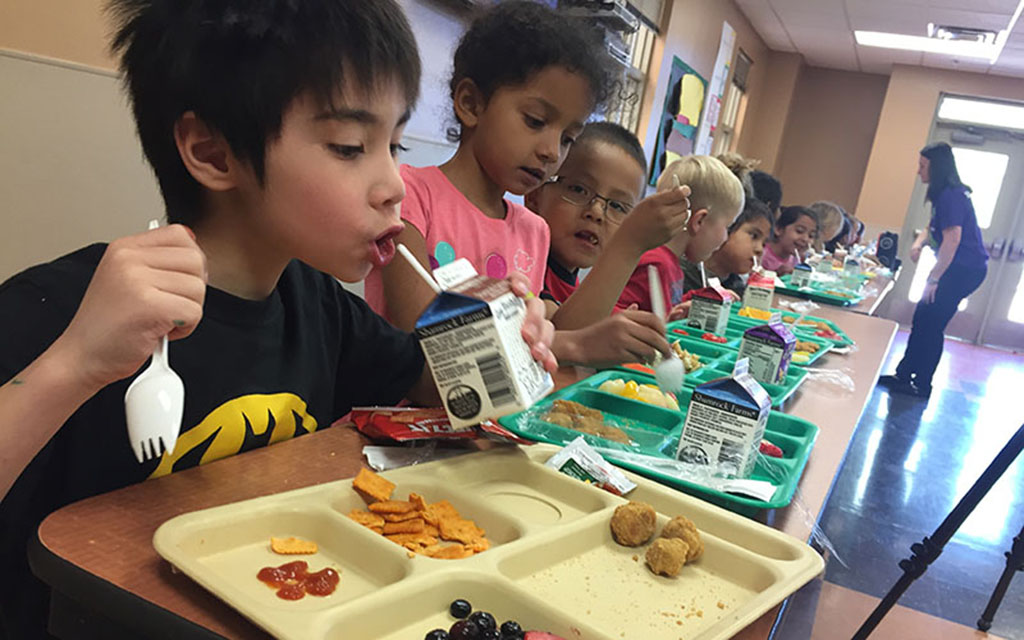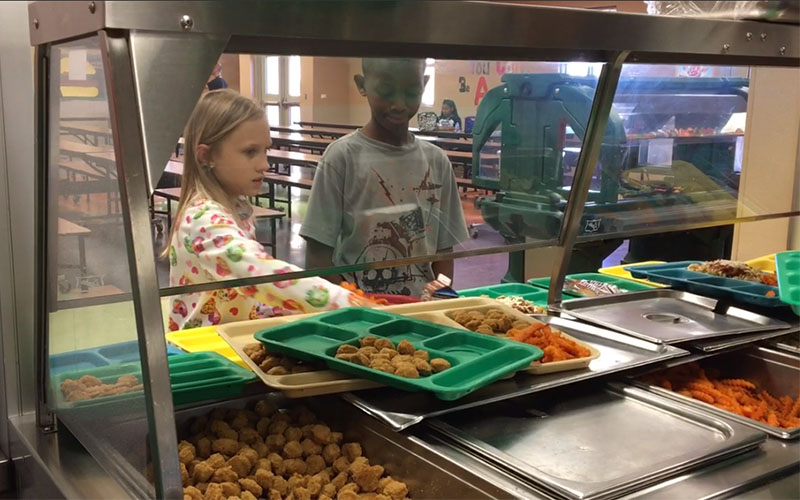- Slug: BC-CNS-Hungry Holidays,1210
- 2 file photos available (thumbnails, captions below)
By Genesis Sandoval
Cronkite News
WASHINGTON – Holidays bring a break from schoolwork for students, but for more than a half-million Arizona children they can also mean a break from their only reliable source of a nutritious meal – the subsidized school meal.
More than 534,000 public school students in the state were eligible for free or reduced-price meals in the 2018-19 school year, the most recent year for which numbers are available from the National Center for Education Statistics. That was 53.7% of the school population.
Nationally, there were more than 26 million children eligible that year for the food program that advocates say is a lifeline for many.
“Every winter break can be a tough time for families that are struggling to put food on the table,” said Crystal FitzSimons, director of school and out-of-school-time programs at the Food Research & Action Center.
“When schools close for winter break, or for summer or spring break, we have millions of kids who lose access to free or reduced-priced school meals,” she said.
FitzSimons says that breakfasts and lunches provided at school are “really important nutrition, health and educational supports for kids.” Ashley St. Thomas, public policy manager at the Arizona Food Bank Network, said that for the students who need them, the school meal “is essentially the most nutritious meal they’ll have all day.”
“There’s this challenge for kids to make sure they are getting enough nutrition for the day,” St. Thomas said. “Without sufficient nutrition, they can’t learn, they can’t grow, they can’t play, they can’t thrive.”
Children are not the only ones affected. FitzSimons said that when children lose access to school meals, the whole family feels the impact.
“It increases the household food budget, which really can have a pretty big impact. Generally when families are food-insecure, the parents try to protect the kids as much as possible by reducing the amount of food that they (the parents) eat or the amount of meals they eat,” she said.
“It also means that families are going to have to stretch very limited budgets in order to put food on the table,” FitzSimons said.
St. Thomas said some parents just do not have the funds to provide their children meals like those they would get at school.
“People who are living paycheck-to-paycheck and are just squeaking by don’t often have extra money stored up for meals over the holidays,” said St. Thomas, who said food banks in the state generally see an increase in families during school holidays.
But advocates have found potential solutions in an unlikely place – the COVID-19 pandemic.
When the pandemic led to widespread school closings, the government decided to make all students eligible for free school meals, regardless of income. That benefit was extended through the 2021-22 school year.
That did not ease the problem of feeding kids during winter break. St. Thomas said, “A lot of kids missed out on free breakfast and lunch that they receive in school, especially now because the USDA stated that all meals are free to all kids throughout the country.” But it did force schools to think differently about their lunch programs.
One of those different approaches was the to-go meal, delivered to socially distanced families.
“Child nutrition programs are operating a little bit differently, and there’s some more flexibility there because of COVID-19,” FitzSimons said. “Schools have been able to do grab-and-go meals so they might be able to have some more flexibility during winter break and provide meals that way.
“Schools should definitely be considering whether providing things like grab-and-go meals would be an option for them over winter break,” she said.
And some advocates have begun to push for a winter break program modeled after the Summer Electronic Benefit Transfer Program, which lets parents buy meals for their children with an EBT card over the summer.
“There’s a movement and a push to make that summer EBT more of an out-of-school EBT, it could be a small amount of money for kids on winter or spring break,” St. Thomas said.
FitzSimons identified winter and spring breaks “as important times when families can really be helped with an EBT program.”
“You could see a program that kicked in during winter and spring break where, if schools were closing for five days or more, families can receive those benefits,” she said.
Whatever the solution, both agreed that something needs to be done for students on break, a time when FitzSimons says that “food insecurity generally goes up.”
“It can be a long winter break if families don’t have access to those meals,” she said.
For more stories from Cronkite News, visit cronkitenews.azpbs.org.
^__=
Web links:
_ Eligible students: https://nces.ed.gov/programs/digest/d20/tables/dt20_204.10.asp
_ School meal programs: https://www.fns.usda.gov/cn
_ COVID changes: https://www.usda.gov/coronavirus/school-meals
_ Summer EBT: https://www.fns.usda.gov/pandemic-ebt-summer-2021#:~:text=Among%20these%20changes%20is%20the%20extension%20of%20P-EBT,reduced%20price%20meals%20during%20the%20current%20school%20year.
^__=
More than a half-million Arizona kids are eligible for free or reduced-price meals at school, but advocates worry that with schools out for the holidays some children will not get the meals they need. Students at Barbara Robey Elementary School eat lunch in this 2017 file photo. (File photo by Lily Altavena/Cronkite News)
Advocates who worry about children missing meals when schools are not in session may have found possible solutions in an unlikely place – the COVID-19 pandemic, which forced innovations in how school meals were delivered during shutdowns. (File photo by Lily Altavena/Cronkite News)

